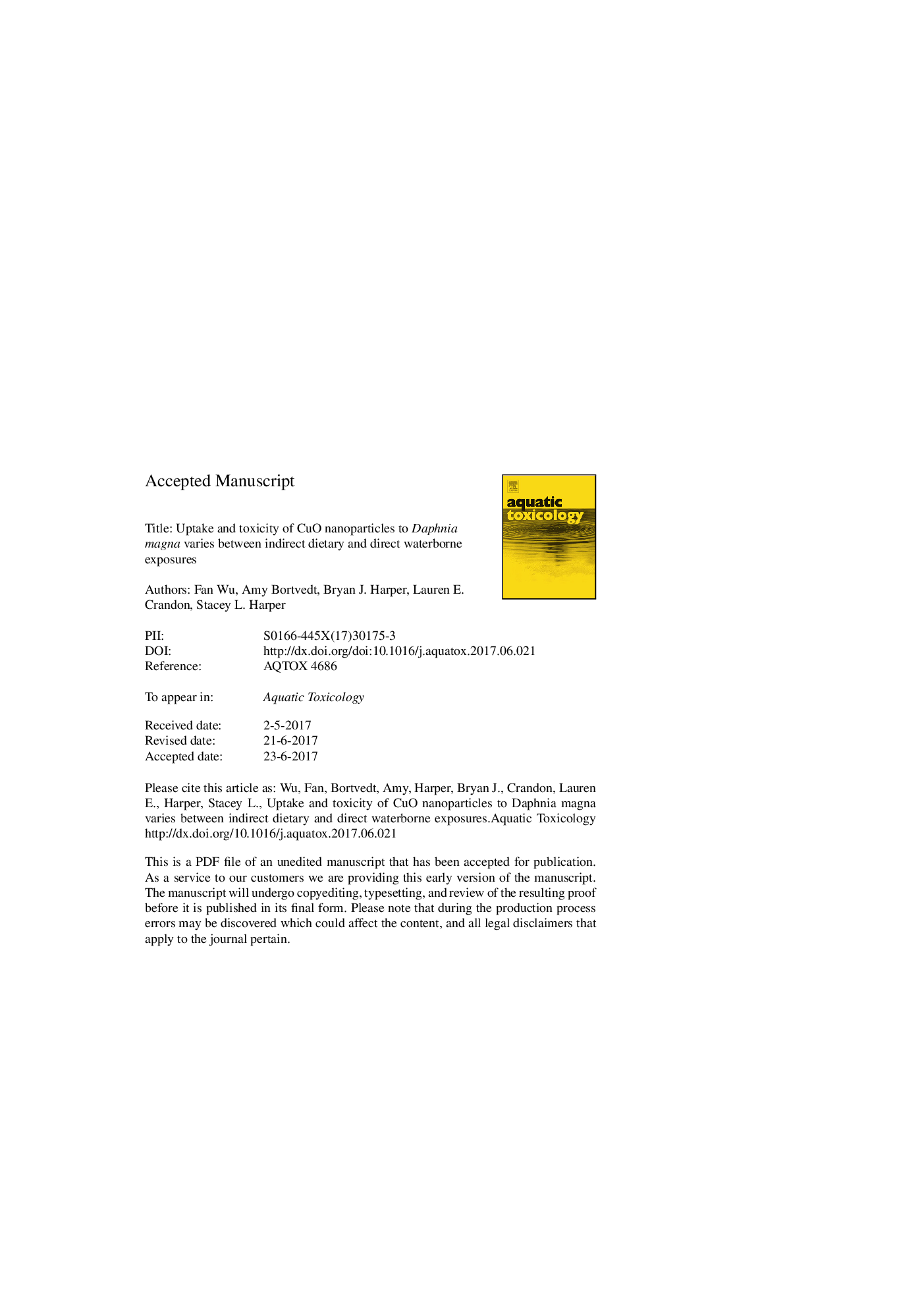| کد مقاله | کد نشریه | سال انتشار | مقاله انگلیسی | نسخه تمام متن |
|---|---|---|---|---|
| 5764270 | 1625915 | 2017 | 33 صفحه PDF | دانلود رایگان |
عنوان انگلیسی مقاله ISI
Uptake and toxicity of CuO nanoparticles to Daphnia magna varies between indirect dietary and direct waterborne exposures
دانلود مقاله + سفارش ترجمه
دانلود مقاله ISI انگلیسی
رایگان برای ایرانیان
کلمات کلیدی
موضوعات مرتبط
علوم زیستی و بیوفناوری
علوم کشاورزی و بیولوژیک
علوم آبزیان
پیش نمایش صفحه اول مقاله

چکیده انگلیسی
Research examining the direct and indirect ecological effects of nanomaterials in aquatic ecosystems is important for developing a more realistic understanding of the environmental implications of nanotechnology. Copper oxide nanoparticles (CuO NPs) are being used extensively in many industries but are considered highly toxic to aquatic species residing in surface waters. Few studies have addressed whether CuO NPs can be transferred through the aquatic food chain, and if such indirect exposure to nanomaterials impacts their toxicity. We investigated the uptake and trophic transfer of CuO NPs from the algae Chlorella vulgaris to the crustacean Daphnia magna and assessed bio-partitioning and resulting toxicity. We hypothesized that CuO NPs can be associated with algal cells and be transported to predators through feeding, and that the chronic toxicity can be altered in comparison to direct CuO NP exposure. For the indirect feeding exposure, algae pre-incubated with CuO NPs (Cu-algae) were washed to remove loose NPs and fed to D. magna while Cu uptake and toxicity were evaluated. For the direct waterborne exposures, a parallel group of D. magna were exposed to equivalent concentrations of CuO NPs while being fed unexposed algae. Using hyperspectral imaging we observed strong surface associations between pre-incubated CuO NPs and algae used in the feeding exposure, and quantified the average Cu content (0.15Â mg Cu/L) with ICP-OES. Cu accumulated in daphnid bodies to a greater extent in direct exposures, whereas molted carapaces and neonate offspring had more copper following the indirect feeding exposure, implying that D. magna may regulate internal Cu differently depending on the method of CuO NP delivery. Significantly higher D. magna mortality was observed following direct exposure relative to feeding exposure, and neonate production from adult daphnids exposed indirectly to CuO NPs was significantly reduced. Thus, nanoparticle interaction with biota at one trophic level may alter the biological response at the next trophic level in a way that is dependent on the delivery scenario. This study highlights the importance of evaluating potential ecological impacts of nanomaterials in more relevant, complex exposure scenarios.
ناشر
Database: Elsevier - ScienceDirect (ساینس دایرکت)
Journal: Aquatic Toxicology - Volume 190, September 2017, Pages 78-86
Journal: Aquatic Toxicology - Volume 190, September 2017, Pages 78-86
نویسندگان
Fan Wu, Amy Bortvedt, Bryan J. Harper, Lauren E. Crandon, Stacey L. Harper,